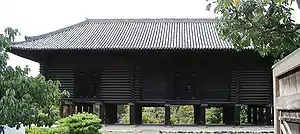Kyōtoku
Kyōtoku (享徳) was a Japanese era name (後花園天皇) after Hōtoku and before Kōshō. This period spanned the years from July 1452 through July 1455.[1] The reigning emperor was Go-Hanazono-Tennō (後花園天皇).[2]
| History of Japan |
|---|
 |
Change of era
- 1452 Kyōtoku gannen (享徳元年): The era name was changed to mark an event or a number of events. The old era ended and a new one commenced in Hōtoku 4.
Events of the Kyōtoku era
- 1453 (Kyōtoku 2, 6th month): The name of the Shōgun, "Yoshinari", was changed to Ashikaga Yoshimasa, which is the name by which he is more commonly known in modern times.[3]
- 1454 (Kyōtoku 3): Ashikaga Shigeuji orchestrated for the killing of Uesugi Noritada,[4] thus beginning a series of conflicts for control of the Kantō; and this event would come to be known as the Kyōtoku no Ran.[5]
Notes
- Nussbaum, Louis-Frédéric. (2005). "Kyōtoku" in Japan encyclopedia, p. 587; n.b., Louis-Frédéric is pseudonym of Louis-Frédéric Nussbaum, see Deutsche Nationalbibliothek Authority File Archived 2012-05-24 at Archive.today.
- Titsingh, Isaac. (1834). Annales des empereurs du Japon, pp. 331-347.
- Titsingh, p. 346.
- Hall, John Whitney. (1988). The Cambridge History of Japan: Medieval Japan, p. 233.
- Nussbaum, "Kyōtoku-no-ran" in Japan encyclopedia, p. 587.
References
- Hall, John Whitney. (1988). The Cambridge History of Japan: Medieval Japan. Cambridge: Cambridge University Press. ISBN 978-0-521-22354-6
- Nussbaum, Louis Frédéric and Käthe Roth. (2005). Japan Encyclopedia. Cambridge: Harvard University Press. ISBN 978-0-674-01753-5; OCLC 48943301
- Titsingh, Isaac. (1834). Nihon Odai Ichiran; ou, Annales des empereurs du Japon. Paris: Royal Asiatic Society, Oriental Translation Fund of Great Britain and Ireland. OCLC 5850691
External links
- National Diet Library, "The Japanese Calendar" -- historical overview plus illustrative images from library's collection
| Preceded by Hōtoku |
Era or nengō Kyōtoku 1452–1455 |
Succeeded by Kōshō |
This article is issued from Wikipedia. The text is licensed under Creative Commons - Attribution - Sharealike. Additional terms may apply for the media files.